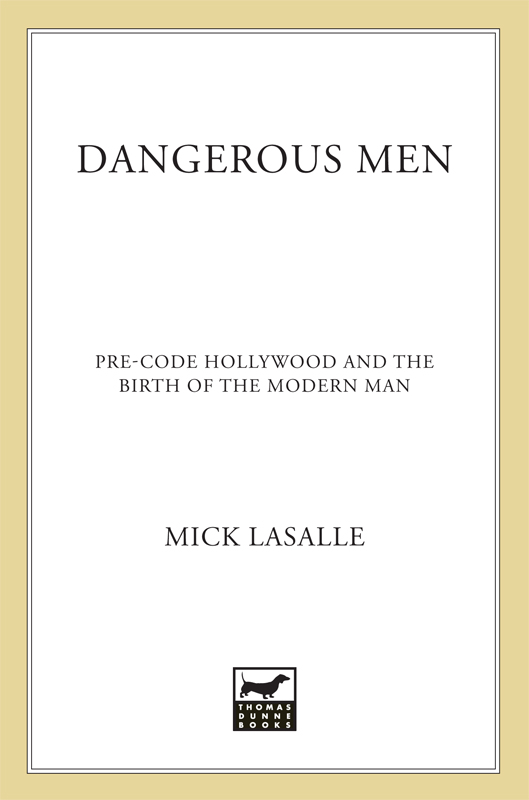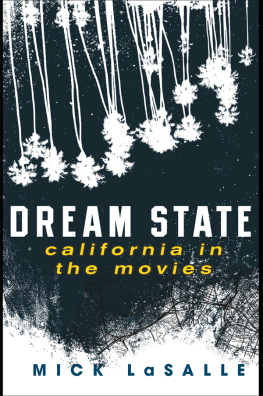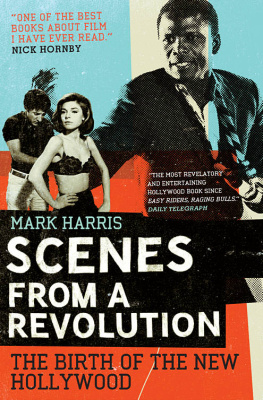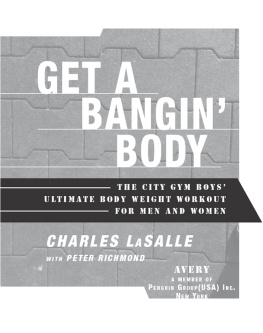LaSalle - Dangerous men: pre-code Hollywood and the birth of the modern man
Here you can read online LaSalle - Dangerous men: pre-code Hollywood and the birth of the modern man full text of the book (entire story) in english for free. Download pdf and epub, get meaning, cover and reviews about this ebook. City: United States, year: 2014, publisher: St. Martins Press;Thomas Dunne Books, genre: Non-fiction. Description of the work, (preface) as well as reviews are available. Best literature library LitArk.com created for fans of good reading and offers a wide selection of genres:
Romance novel
Science fiction
Adventure
Detective
Science
History
Home and family
Prose
Art
Politics
Computer
Non-fiction
Religion
Business
Children
Humor
Choose a favorite category and find really read worthwhile books. Enjoy immersion in the world of imagination, feel the emotions of the characters or learn something new for yourself, make an fascinating discovery.

- Book:Dangerous men: pre-code Hollywood and the birth of the modern man
- Author:
- Publisher:St. Martins Press;Thomas Dunne Books
- Genre:
- Year:2014
- City:United States
- Rating:4 / 5
- Favourites:Add to favourites
- Your mark:
- 80
- 1
- 2
- 3
- 4
- 5
Dangerous men: pre-code Hollywood and the birth of the modern man: summary, description and annotation
We offer to read an annotation, description, summary or preface (depends on what the author of the book "Dangerous men: pre-code Hollywood and the birth of the modern man" wrote himself). If you haven't found the necessary information about the book — write in the comments, we will try to find it.
LaSalle: author's other books
Who wrote Dangerous men: pre-code Hollywood and the birth of the modern man? Find out the surname, the name of the author of the book and a list of all author's works by series.
Dangerous men: pre-code Hollywood and the birth of the modern man — read online for free the complete book (whole text) full work
Below is the text of the book, divided by pages. System saving the place of the last page read, allows you to conveniently read the book "Dangerous men: pre-code Hollywood and the birth of the modern man" online for free, without having to search again every time where you left off. Put a bookmark, and you can go to the page where you finished reading at any time.
Font size:
Interval:
Bookmark:


The author and publisher have provided this e-book to you for your personal use only. You may not make this e-book publicly available in any way. Copyright infringement is against the law. If you believe the copy of this e-book you are reading infringes on the authors copyright, please notify the publisher at: us.macmillanusa.com/piracy.
Contents
(Douglas Fairbanks, Rudolph Valentino, Ramon Novarro, John Gilbert, and Lon Chaney)
(Al Jolson, John Gilbert, Ramon Novarro, Gary Cooper, and George Arliss)
(Chester Morris, Lew Ayres, Edward G. Robinson, and James Cagney)
(James Cagney, Clark Gable, Edward G. Robinson, and Paul Muni)
(Lon Chaney, Boris Karloff, Bela Lugosi, Charles Laughton, and Fredric March)
(Richard Barthelmess, David Manners, Richard Dix, Fredric March, the Marx Brothers, Lionel Barrymore, and George Bancroft)
(Lee Tracy, Douglas Fairbanks, Jr., Edward G. Robinson, William Powell, James Cagney, Warren William, Robert Montgomery, and John Gilbert)
(James Cagney, Clark Gable, Rudolph Valentino, Warren William, Cary Grant, Gary Cooper, Richard Barthelmess, Ramon Novarro, William Powell, Robert Montgomery, Maurice Chevalier, and Bing Crosby)
(Warren William, George Arliss, Richard Dix, Edward G. Robinson, and Douglas Fairbanks, Jr.)
(John Barrymore, Charles Laughton, Edward G. Robinson, Richard Barthelmess, Charlie Chaplin, Spencer Tracy, Warren William, Fredric March, Gary Cooper, and Norman Foster)
(James Cagney, Dick Powell, Paul Muni, Douglas Fairbanks, Jr., Walter Huston, Frankie Darro, and Richard Barthelmess)
F OR MY FATHER,
WHO ONLY LOOKS DANGEROUS,
AND MY MOTHER,
WHOS MORE DANGEROUS THAN SHE LOOKS
Introduction
M ANHOOD IS NO easy subject. When does it begin? What qualities does it consist of? Girls who are eighteen start calling themselves women as soon as they enter college, while boys the same age tend to think of themselves as guys. The concept of manhood is too imposing, so associated with heroics and domination that it seems like an effrontery to assume automatically the mantle at eighteenor even at twenty-one.
Anyone writing a book about women would have no trouble identifying examples of women with admirable traits. But in the case of men, there is less common ground. Everyone has an opinion about manhoodgood, bad, and uglyand manhood itself is often under attack.
This book concerns images of manhood in the five years before American cinema went off the tracks and gave up truth telling for propaganda. That five-year period, known today as the pre-Code era, lasted from 1929 to mid-1934. It was an era of lax censorship that finally ended with the imposition of a harsh Production Code that would, for the next thirty-four years, censor much of the life and honesty out of American movies. If today most people think of old movies as staid and safe, its because theyre only familiar with the classic films made under this Code, which mandated chastity, blind respect for authority, and knee-jerk patriotism. The Code also guaranteed that all crime had to be punished, even if the criminal was really handsome or funny, even if the criminal was right.
The pre-Code era coincided with an interesting time for men, the culmination of a generation-long transformation of the masculine ideal. By the late twenties, the tumult of the new century had made the nineteenth centurys notion of the ideal man seem like a rigid buffoon, a repressed stuffed shirt, a deluded optimist, a bull waiting to be made into hamburger. Young men had turned away from an image of manhood as buttoned-down and dour and rejected their fathers schizophrenically compartmentalized notions about women and sexuality. Men were finding their way toward a modernity more spontaneous, more jaded, and more instinctive.
In the pre-Code era, conflicts and currents building for decades reached critical mass and found an outlet. The New Woman became the subject of a whole genre of films. With equal thoroughness, movies looked at the New Man, taking on subjects such as crime, politics, business, sex, and war. The depiction of these subjects was colored by recent eventsthe nightmare that was World War I, the widespread disgust with Prohibition, and, later, the economic terror surrounding the Great Depression. Grown men began to look upon government and business with a jaundiced eye. They looked at these institutions and reacted with language once reserved for the carnival barker: Are you trying to make a sucker out of me? Do you think Im a chump? A sap? Old notions about the glory of battle and the importance of a womans virtue were tossed overboard, and anything that got in the way of personal freedom was suspect.
In pre-Code movies, men do more than adopt received behavior. They improvise. They chart a path. Its the common thread that unites the actors who thrived in this era. They epitomized the outsiders understanding of life. From the impish subversion of Cagney, to the tragic grandeur of Lon Chaney, to the loneliness and integrity of Richard Barthelmess, pre-Code heroes acknowledged the world as a jungle and did the best they could.
In the silent days, a screen hero was someone who looked and acted like the audiences traditional conception of a hero. In the pre-Codes, we leave the age of heroic types and enter an age that celebrates individuality. Stories were built around actors who fit no preconceived mold. Rascals and gangsters were allowed vitality and charm. A decade before, Clark Gable, a gruff, big-eared screen villain, might have been tying virgins to railroad tracks. In the early thirties, men and women idolized him, the fellow who bucks the system.
Two assumptions dominated the pre-Code era, one cynical, one romantic. The cynical assumption was that the system was rigged, that if you played by the rules, youd lose. The romantic assumption was that if you were shrewd and brave enough, you could beat the system at its own game. We find these assumptions everywhere in the pre-Codes, whether in the tragic Little Caesar character of Edward G. Robinson, the fast-talking hustlers of Lee Tracy, or in the comic charlatans of the amazing Warren William. At the same time, pre-Code men wrestled with morality as an imperative of manhood. We see that especially in the films of Barthelmess and Fredric March.
Its the profound irony of the Production Codes imposition: Before the censors shoved morality down the publics throat, movies were never more fixated on moral issues. After the Code arrived, American movies were all about, Who will win, the good guy or the bad guy? But before the Code, movies explored the morality of business, the morality of law, the morality of romance. Movies asked, Who is the good guy? Who is the bad guy? And why? And how can we tell? And whos to decide?
Such questions were threatening to traditionalists, whod already divined the answers for themselves and everybody else. No wonder they mobilized.
* * *
OTHER BOOKSINCLUDING my own Complicated Women: Sex and Power in Pre-Code Hollywood have dealt, in detail, with how American movies came to be controlled by a backward and draconian Production Code. For our purposes, it will suffice to say that: First, it happened; and second, it was not the result of widespread public reaction against the motion picture industry. (Had it been, we could say that a censored cinema was an expression of the public will.) Rather, it was the result of a well-organized effort by a small cabal of lay Catholics, who, working both within the church and the film industry, threatened the studios with a loss of Catholic business if certain demands werent met.
Font size:
Interval:
Bookmark:
Similar books «Dangerous men: pre-code Hollywood and the birth of the modern man»
Look at similar books to Dangerous men: pre-code Hollywood and the birth of the modern man. We have selected literature similar in name and meaning in the hope of providing readers with more options to find new, interesting, not yet read works.
Discussion, reviews of the book Dangerous men: pre-code Hollywood and the birth of the modern man and just readers' own opinions. Leave your comments, write what you think about the work, its meaning or the main characters. Specify what exactly you liked and what you didn't like, and why you think so.





